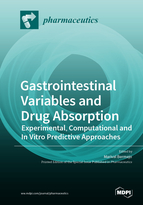Gastrointestinal Variables and Drug Absorption: Experimental, Computational and In Vitro Predictive Approaches
A special issue of Pharmaceutics (ISSN 1999-4923).
Deadline for manuscript submissions: closed (28 February 2019) | Viewed by 65120
Special Issue Editor
Interests: oral absorption; intestinal permeability methods; in vitro-in vivo correlations; PK modelling
Special Issues, Collections and Topics in MDPI journals
Special Issue Information
Dear Colleagues,
Gastrointestinal (GI) variables dictate the fate of any oral drug product as in vivo product disintegration, dissolution, transit and drug permeation determine absorption rate and extent. Nevertheless, the gut remains as the final frontier at many levels, which will need new navigation methods to unravel how its dynamic changes, either in healthy subjects or in patients, in fasted or fed state, affect and are affected by the pharmaceutical product. In the last decades, human intubation studies or dosage-form-like sensors have brought in new information about transit, motility, fluid volumes and composition and a partial picture of the in vivo dissolution process while non-invasive methods, such as MRI, are being validated for the same purpose. Combined with computational fluid dynamic experiments these methods will permit the design of new dissolution devices covering the adequate range of critical variables adapted to all BCS classes as drug-product development tools and eventually bioequivalence test devices. The aim of this Special Issue is to highlight the latest developments in oral biopharmaceutics from the experimental methods to study GI variables to its application to in vivo predictive tools and models.
Prof. Marival Bermejo
Guest Editor
Manuscript Submission Information
Manuscripts should be submitted online at www.mdpi.com by registering and logging in to this website. Once you are registered, click here to go to the submission form. Manuscripts can be submitted until the deadline. All submissions that pass pre-check are peer-reviewed. Accepted papers will be published continuously in the journal (as soon as accepted) and will be listed together on the special issue website. Research articles, review articles as well as short communications are invited. For planned papers, a title and short abstract (about 100 words) can be sent to the Editorial Office for announcement on this website.
Submitted manuscripts should not have been published previously, nor be under consideration for publication elsewhere (except conference proceedings papers). All manuscripts are thoroughly refereed through a single-blind peer-review process. A guide for authors and other relevant information for submission of manuscripts is available on the Instructions for Authors page. Pharmaceutics is an international peer-reviewed open access monthly journal published by MDPI.
Please visit the Instructions for Authors page before submitting a manuscript. The Article Processing Charge (APC) for publication in this open access journal is 2900 CHF (Swiss Francs). Submitted papers should be well formatted and use good English. Authors may use MDPI's English editing service prior to publication or during author revisions.
Keywords
- in vivo dissolution
- Human intubation studies
- MRI
- manometry
- computational fluid dynamics
- oral absorption
- bioequivalence
- Gastrointestinal motility
- Human intestinal fluids
- BCS
- intestinal permeability
- In vitro dissolution methods







